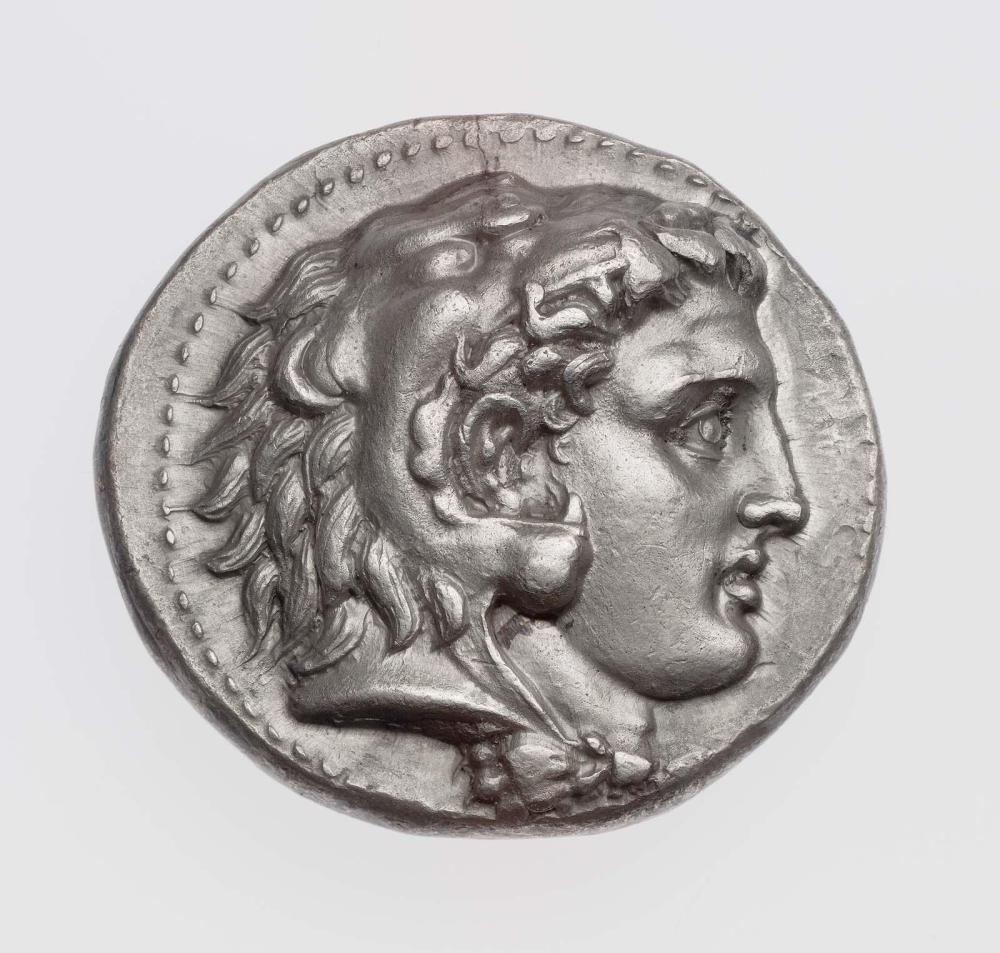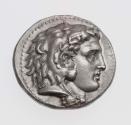Advanced Search
Tetradrachm of Kingdom of Macedonia with head of Herakles, struck in the name of Alexander III
Greek
Early Hellenistic Period
332–323 B.C.
Mint: Macedonia (Kingdom), Memphis (Egypt)
Medium/Technique
Silver
Dimensions
Diameter: 28 mm. Weight: 17.05 gm.
Credit Line
Henry Lillie Pierce Fund
Accession Number04.729
CollectionsAncient Greece and Rome
ClassificationsNumismatics – Coins
Zeus, the supreme deity of the Classical pantheon, was believed to govern the affairs of both gods and humans. The most famous image of the god, made by the illustrious fifth-century-B.C. Athenian sculptor Phidias, was a colossal statue of ivory and gold that stood in his temple at Olympia. Acknowledged in antiquity as one of the seven wonders of the world, the statue does not survive, but its influence can be seen in other representations of Zeus in ancient art.
Phidias's statue of Zeus also exerted a powerful hold on Classical antiquity's most famous king, Alexander the Great of Macedonia. The invincible chief of the gods was a fitting emblem for a young man who was himself aspiring to take over the world. An image of Zeus reminiscent of the Olympian model was chosen to adorn silver coins struck at various mints located throughout Alexander's dominion. The god's pose, enthroned and gripping a scepter with his left fist, corresponds to written descriptions of the renowned statue. The coins diverge from the monumental prototype, however, by showing an eagle, a bird closely associated with Zeus, perched on the god's outstretched right hand.
Phidias's statue of Zeus also exerted a powerful hold on Classical antiquity's most famous king, Alexander the Great of Macedonia. The invincible chief of the gods was a fitting emblem for a young man who was himself aspiring to take over the world. An image of Zeus reminiscent of the Olympian model was chosen to adorn silver coins struck at various mints located throughout Alexander's dominion. The god's pose, enthroned and gripping a scepter with his left fist, corresponds to written descriptions of the renowned statue. The coins diverge from the monumental prototype, however, by showing an eagle, a bird closely associated with Zeus, perched on the god's outstretched right hand.
Catalogue Raisonné
Brett, Greek Coins (MFA), no. 0680; Highlights: Classical Art (MFA), p. 031.
DescriptionObverse: Head of youthful Herakles to right with lion's skin.
Beaded border.
Reverse: Zeus, laureate, sits to left on throne without back, a himation over his knees, right foot drawn back on foot stool, an eagle on right hand, left hand on sceptre. Sceptre beaded.
At left, a rose in profile.
Below throne and at right: inscriptions in Greek.
Beaded border.
Probably satrapy of Ptolemy I striking in the name of Alexander III.
Beaded border.
Reverse: Zeus, laureate, sits to left on throne without back, a himation over his knees, right foot drawn back on foot stool, an eagle on right hand, left hand on sceptre. Sceptre beaded.
At left, a rose in profile.
Below throne and at right: inscriptions in Greek.
Beaded border.
Probably satrapy of Ptolemy I striking in the name of Alexander III.
ProvenanceBy date unknown: Canon Greenwell Collection (according to MFA file card); July 1902: acquired from Canon Greenwell Collection by Edward Perry Warren; September, 1904
(Note that this piece is not listed by Regling, Die Griechischen Münzen der Sammlung Warren, as coming from the Greenwell collection)
(Note that this piece is not listed by Regling, Die Griechischen Münzen der Sammlung Warren, as coming from the Greenwell collection)




